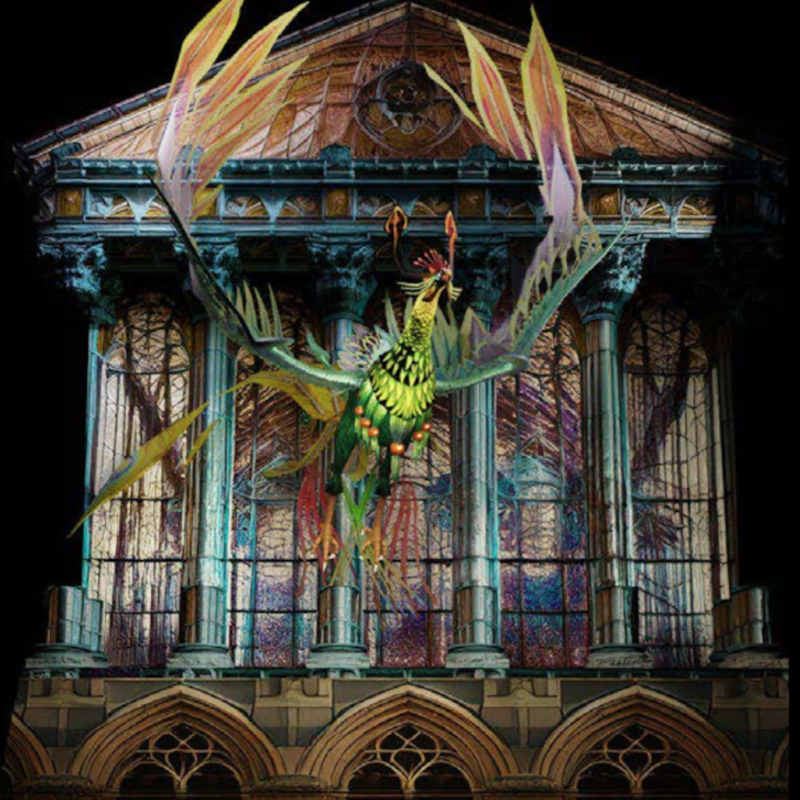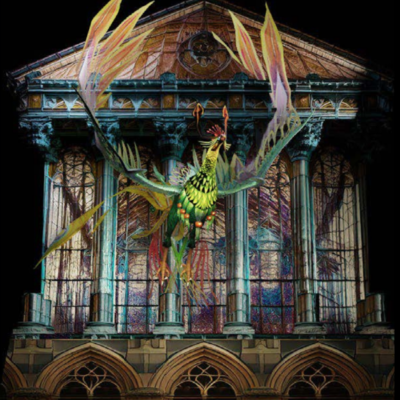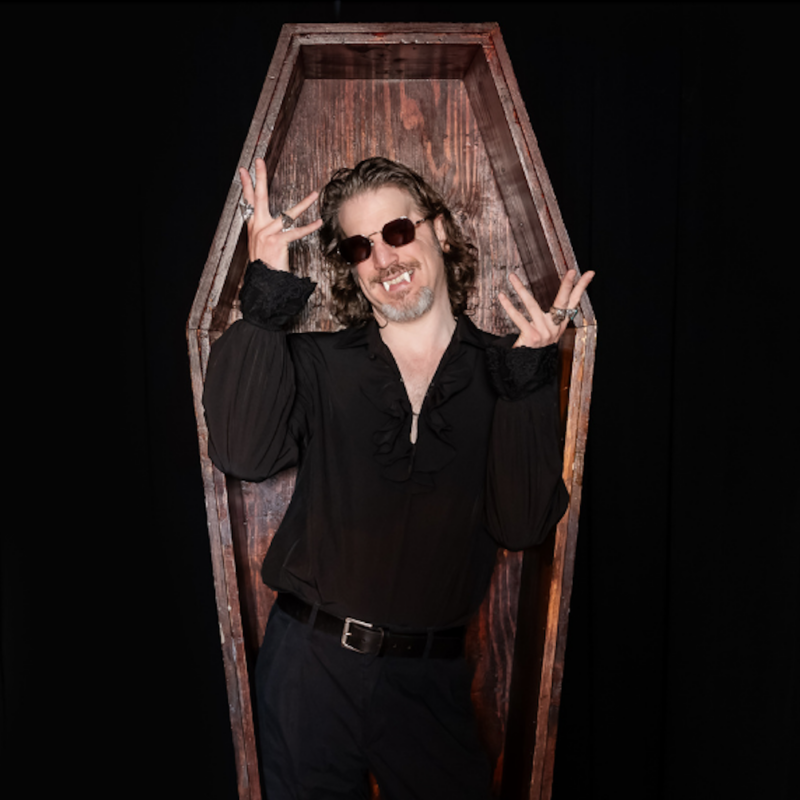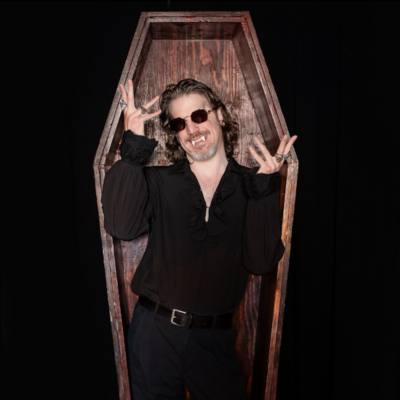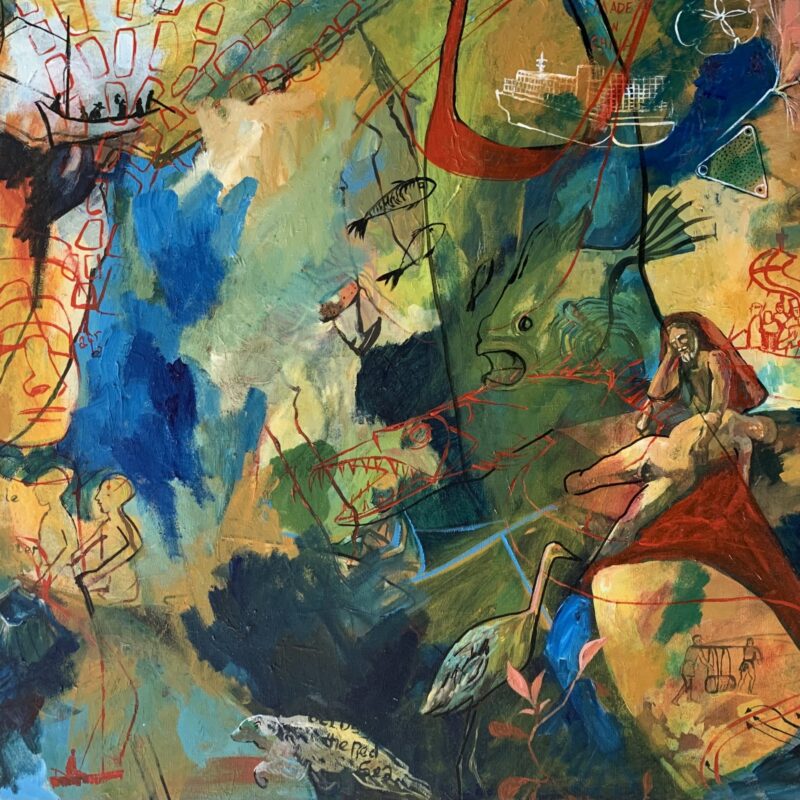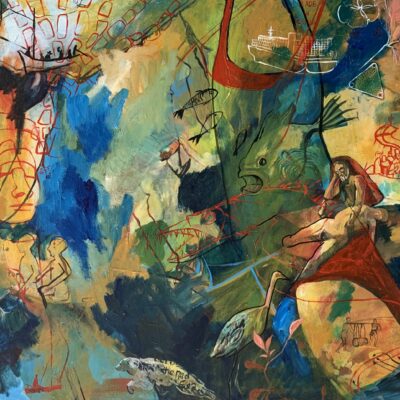Thick trunked and limbless, a gray-brown tree reaches from floor to ceiling against Second Street Gallery‘s back wall, presiding over the handful of staff members collected to assemble Andrew Schoultz‘s November exhibit, "The End of the World and Other Stories."
 Horses of the apocalypse: Andrew Schoultz paints the signs of things to come across the wall of Second Street Gallery for his November exhibit, "The End of the World and Other Stories." |
From around the base of this central wooden tower run paths that lead to cement-and-brick pyramids; these structures loom over three wooden triangular prisms that stand in a cluster near the center of the gallery’s floor. At the right side of the wall stands a snorting, sinewy bronco, its body the hull of a wooden boat, ghosted by the outline of another horse on the opposite side of the wall. Red swoops of dust or dirt, kicked up by the stamping hooves of each beast, swirl in all directions, like scared birds.
Andrew Schoultz descends a ladder in front of the half-finished horse, dismounting it with a cup of coffee in hand, and bids Curtain Calls a hello. Schoultz is in his 30s, wears brown Saucony sneakers, paint-streaked khaki pants and a t-shirt from the Track 16 art gallery in Los Angeles where he covered a wall with similar designs from his bag of symbols—birdhouses, brick and armless trees, rendered in a style somewhere between folk and street art. A backwards baseball cap restrains his hair while little restrains the scent of coffee on his breath—the last few nights have been late, and Schoultz was at Second Street ’til 3am ("They gave me a key") the previous night, only to return to tell a class of eighth graders from the Peabody School about his work so that they could return to school and try a mural of their own.
Charlottesville’s Neighborhood Development Services website lists that the best way to combat recurring graffiti violations of public or private buildings is to clean everything up within five days of an illicit art sighting, but Schoultz has circumvented the system legitimately, moving from graffiti through the international gallery circuit. Second Street director Leah Stoddard first saw Schoultz at the Scope New York Art Fair in 2005 (the same show where, during a different year, Stoddard spotted Suzannah Sinclair, who is hanging wood panels of watercolor nudes for "Your Silent Face," her exhibit in Second Street’s Dové Gallery), and invited Schoultz to compose a mural for Second Street’s November exhibit. By the time December 1 arrives, Schoultz’s mural will be entirely painted over.
Video of Andrew Schoultz talking about his mural at Second Street Gallery. |
"With a lot of these short-term projects, I feel more comfortable taking on edgy subjects," says Schoultz, who speaks of his interest in pairing modern and timeless objects to tell repetitive stories of war and economic proliferation, but is reluctant to give his audiences a definitive tale.
"In public spaces, I’m not trying to punch people in the face," says Schoultz. "That’s irresponsible. That’s what advertisers do."
For all of the styles and ages competing for dominance on Schoultz’s mural, he’s absolutely right about his delivery: His mural pops with the intensity of a landscape by Warner Bros., enough to set a child’s mind down any one of the brick pathways that stretch from the gnarls of Schoultz’s enormous tree. Curt’s mind detours down a path.
Walk in the park
Elvira Hoskins, one of the three "Downtown mothers" that started Friends of McGuffey Park roughly four years ago, speaks of the park now like a mother sharing tales of a young problem child. "Equipment was failing, and it would be moved and not replaced," she says. "Illicit activity was going on there. It started being underutilized."
Following a tip from Peter O’Shea and Jordan Phemister of Siteworks Studio, the landscape architecture firm designing the renovations, Hoskins reached out to Beryl Solla, a mosaic artist and art department chair at Piedmont Virginia Community College, with the idea of composing a mural that overlapped with Siteworks’ design concept of building the park’s infrastructure according to its original infrastructure.
"The design of the mural is based on trees and flowers that are going to be planted there, or already are there," says Solla. "Poplars, azaleas, rhododendrons—all more-or-less true to the plantings that will be in the park. Always in bloom, always welcoming."
Friends of McGuffey procured a mass of tiles ("It’s an outdoor surface, so the tiles had to be frost-free. And, when you use donated tile, it’s hard to get the colors you want") and Solla and Hoskins coordinated volunteers—up to 30 people each weekend day, and averaging roughly 20 people on weekdays—through October to break tiles then apply them along the inside of the stone wall facing High Street. Solla planned a color-by-numbers style of tile application and trained coordinators to apply the tiles while Hoskins and others oversaw the implementation.
Though the park will reopen on November 10 (according to Hoskins), CC dropped by a week early to check out the mosaic mural. Through the chain link fence are visible small shards of purples, reds and yellows, grouped in nearly seamless clusters, control and effort casting new color on McGuffey Park.
Where were we?
Curt snaps back to attention in Second Street Gallery speaking to Suzannah Sinclair, who is guiding CC through her exhibit of centerfold nudes on wood, entitled "Your Silent Face," a collection of breasts riding the knots and swirls of the panels.
"Since the way I draw is so controlled," says Sinclair, a thin, fair- and freckle-skinned woman whose v-necking blue t-shirt reveals the word "precious" tattooed in dark ink, "the wood adds an element that I can’t." Sinclair works with watercolors and a mechanical pencil; her portraits are "very delicate, but on a sturdy object."
"On paper," she says, "they might look too precious."
Does art require a challenge to be worthwhile? Is a mural that fights international conflict, or a mosaic that fights to revive land or a penciled nude struggling to appear from the time-ingrained swirls of wood, somehow more rewarding? Curt considers, then returns to Schoultz’s mural to let his mind wander a new path.
Got news or comments? Send them to curtain@c-ville.com.
